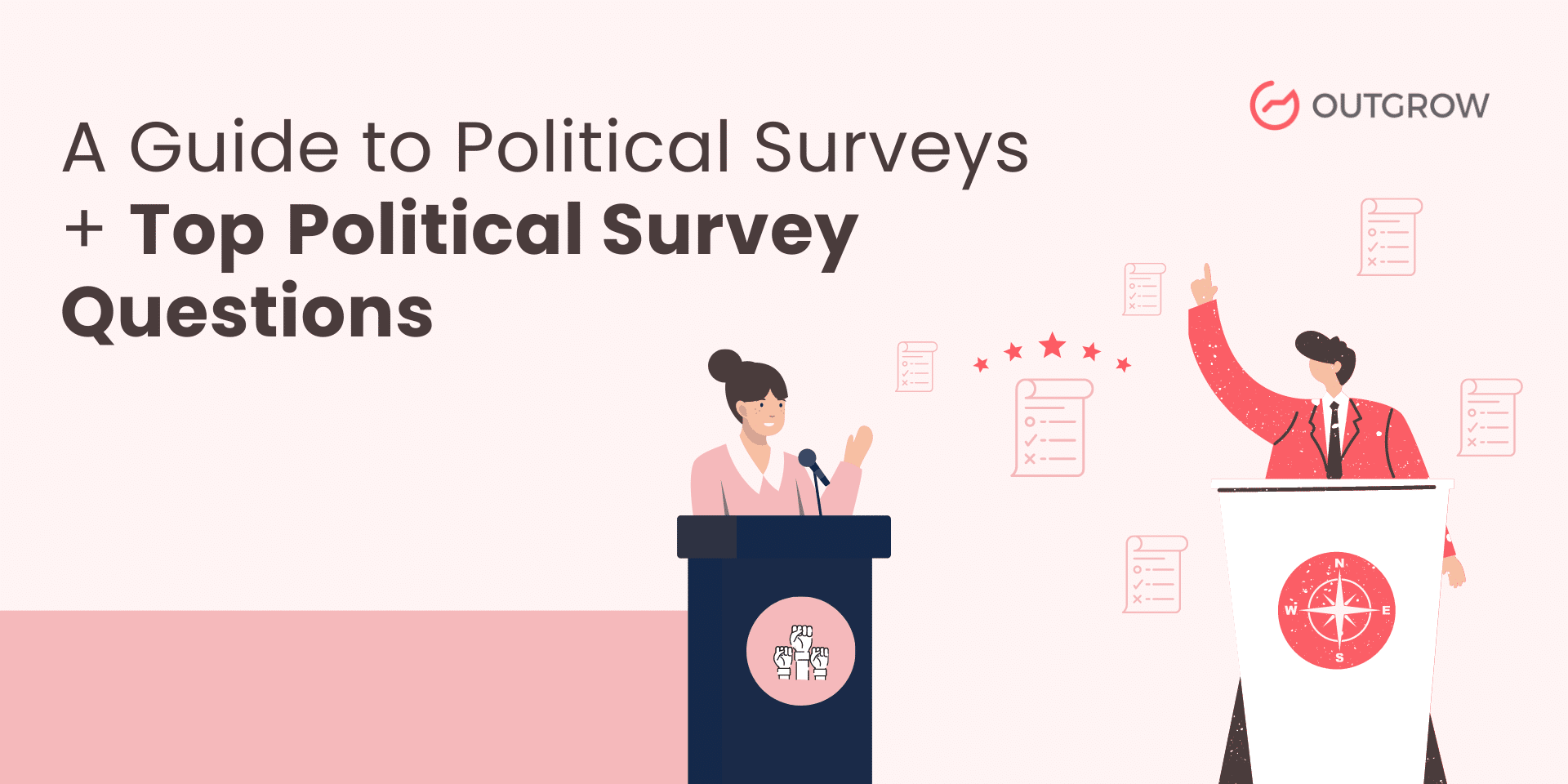

Conducting a political survey is an integral part of modern politics. But creating a survey that captures the voters’ spirit could be challenging. If you want to create political survey questions that accurately grasp people’s opinions, there are specific guidelines you should consider.
So in this blog, we will give you 50 question ideas and also explore some best practices and steps to create a political survey.
A political survey is a way of data collection from individuals in order to understand their political opinions, attitudes, and behaviors.
Political surveys ask a series of questions that cover a wide range of topics, such as voting behavior, party affiliation, views on current political issues, and opinions on specific politicians or policies. It could also include questions that seek demographic information such as age, gender, education level, and income.
The results of political surveys can be used by political candidates, parties, and organizations to better understand their target audience and shape their campaign strategies. Additionally, political surveys can be used by researchers and academics to analyze political trends and patterns within society.
One notable successful political survey campaign was conducted by Obama for America campaign during the 2012 United States presidential election. The campaign employed an extensive survey strategy known as “Targeted Sharing” to gather valuable insights and engage with supporters.
The campaign utilized online surveys to collect data on voters’ priorities, policy concerns, and personal stories. They strategically designed the surveys to be engaging and interactive, making it more likely for supporters to participate and share their responses with their social networks.
Some fundamental reasons and benefits for conducting political surveys are-
Political surveys enable the measurement of public perspectives on various political topics, such as policies, candidates, and issues. By analyzing survey data, policymakers and politicians can gain a better understanding of people’s concerns and what they value.
Political surveys are commonly used during election campaigns to assess voter sentiment and preferences. This information is used by candidates to shape their campaign strategies and target their messages to the voters who are most likely to support them.
Through the collection of data from numerous surveys over time, analysts can track changes in public opinion on political issues. Policy makers can use this information to stay informed of the public’s evolving attitudes and respond accordingly.
By testing political messages and ideas through surveys, candidates and policymakers can fine-tune their messaging to better resonate with the public. This helps to ensure that their messaging is as effective as possible.
Political surveys are a valuable tool for investigating political phenomena, such as the effects of policies on the public and voter behavior. The results of these surveys can provide policymakers with the information they need to make informed decisions.

A good survey design is not about finding the right questions. It is about finding the right audience.
The best way to do that is to conduct a preliminary audience analysis and come up with a list of topics that you think your audience would find interesting and relevant. This will give you an idea of what kinds of questions they are interested in, how they prefer to learn about things, and what kind of information they are seeking.
The first decision to make is what type of survey will work best for your study. You’ll also need to consider your project timeline and how much data you can collect in that duration.
Furthermore, you will have to understand whether you want to use paper or electronic surveys. Electronic surveys are convenient because they allow you to collect more information from your respondents in less time. However, some find it challenging to design a survey. Would I need coding knowledge? How to share and promote an online survey? How much would a survey maker cost?
Well, if you’re looking for a no-code, easy-to-use, easy-to-share, free survey tool, check out Outgrow Survey Maker!
If you want a step-by-step guide on how to make a survey, you can check out this detailed blog.
A logic jump is a feature in surveys that allows respondents to dynamically skip or move to specific questions based on their current answers.
This can be used to improve the survey experience for respondents by making it shorter and more relevant for them. This also improves the quality of the data collected for you as users only answer the questions that apply to them.
For example, you could use a logic jump to help users skip a question about income if they have already answered that they are not employed.
Another feature you can try for specific sensitive parts is ‘skip question’. Clearly, this would help the respondent to skip any question that they don’t want to answer. This would encourage people to continue with your survey even if they are not comfortable with some questions.
The best political survey questions are short, simple, and to the point. It is widely accepted that the more information you give people in a survey, the less likely they are to take your survey seriously.
Therefore, if you want your survey to be seen as an expert source of data, keep it short and to the point. This will also help you gather more accurate data.
Avoid ambiguous, misleading, or double-barreled questions as that will only confuse the reader and therefore, lead to unreliable or inaccurate data.
An important part of designing a survey is to choose the right response format for each question.
You can use an open-ended question, which means that the respondent has to answer in their own words. Or you can use a close-ended question, which means the respondent will be able to choose from an available list of response options.
You can also use a rating scale for comparative questions. Response formats like the Likert scale are commonly used allowing respondents to rate their level of agreement or disagreement with a statement. This format helps measure the intensity or strength of opinions on a numerical scale, providing more precise data for analysis.
There are various types of survey questions you should try out to fit your unique requirements.
This helps when asking multiple questions on the same topic as the respondent won’t feel confused while taking the survey. It’s important to make sure that each question relates to the others in your survey. You can also use an outline format to help with this process.
In order to check the efficacy of the survey that you have created, it is important to test it out yourself.
Testing your survey before sending it out can help you to:
1. Enhance the quality of the data collected by identifying and fixing any problems with the survey questions, such as ambiguity, bias, or technical issues.
2. Improve the survey experience for respondents by making sure that the survey is easy to understand and complete.
3. Increase the validity and reliability of the survey results by ensuring that the survey is measuring what you intend it to measure and that the results are consistent.